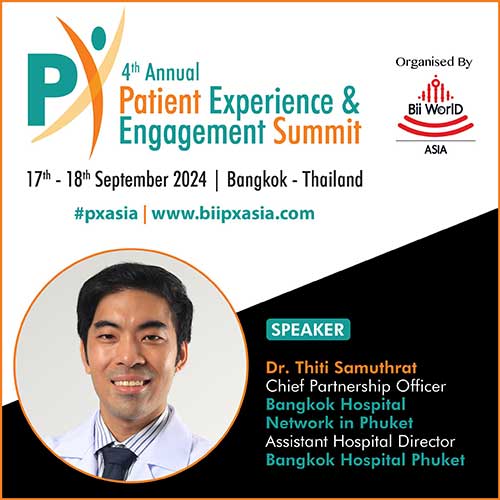1. How do you see the integration of technology and human touch reshaping patient experience in today’s healthcare landscape?
As the Assistant Hospital Director, I see the integration of technology and human touch fundamentally reshaping patient care by enhancing communication, personalizing treatment, and improving care coordination. Telehealth, AI, and data analytics enable convenient access and tailored care, empowering patients to manage their health actively. With data and CRM program usage, we understand each patient’s needs more effectively, allowing us to personalize treatment options and care based on individual conditions. Patients’ likes and dislikes can also be recorded in the CRM system and notified prior to their arrival, ensuring a morem personalized experience. Streamlined processes through automation free up providers to focus on compassionate interactions, ensuring the human connection remains strong. Additionally, technology helps address healthcare disparities by reaching underserved populations, such as those needing follow-up care or further check-ups who might have been missed earlier. This balanced integration creates an efficient, personalized, and empathetic healthcare environment, meeting today’s needs and setting the stage for a more connected and caring future.
2. Can you share specific examples or case studies where technology has significantly enhanced patient engagement and experience in your practice or organization?
At Bangkok Hospital Network in Phuket, technology has significantly enhanced patient engagement and experience through several initiatives. For example, we have implemented a CRM system that tailors our services to individual patient needs using data-driven strategies, allowing us to provide highly personalized treatments and care that address not only health but also lifestyle. Additionally, we introduced wearable health devices, such as sleep monitoring rings, which help patients proactively manage their health. Furthermore, we have platforms that create communities for our patients to share feedback and ideas, and to stay updated on upcoming events and activities based on each nationality. These technological advancements collectively enhance patient engagement and improve the overall patient experience at Bangkok Hospital Network in Phuket.
3. What challenges do healthcare providers face when balancing technological advancements with maintaining a personal, human touch in patient care?
As the Assistant Hospital Director, I see several challenges in balancing technological advancements with maintaining a personal touch in patient care. Over-reliance on technology, like chatbots, can feel impersonal and lead to miscommunication, so we are planning to use them for general inquiries only. Technical issues and system failures can disrupt care, and keeping up with rapid advancements is demanding. Some patients feel telehealth is not as personal, so we provide cultural training for our staff to address this. Our goal is to ensure technology enhances, rather than replaces, the personalized, compassionate care our patients deserve. When technology is disrupted, human touch must continue to provide seamless, empathetic care.
4. In your opinion, what are the key technological trends that will drive the future of patient experience and engagement?
In my opinion, key technological trends driving the future of patient experience and engagement include the expansion of telehealth for greater accessibility, AI and machine learning for personalized medicine, and wearable health devices for real-time health monitoring. For instance, we provide a sleep monitoring ring for our patients to track their sleep patterns. Patient portals and mobile health apps will improve communication and access to medical records, while remote monitoring enables continuous tracking of health metrics. Blockchain will enhance data security, and VR/AR can aid in patient education and rehabilitation. Lastly, chatbots and AI-powered assistants will handle routine tasks, allowing healthcare providers to focus on complex patient care. These trends will collectively enhance patient engagement, improve outcomes, and create a more personalized healthcare experience.
5. How do you ensure that technological innovations in healthcare are accessible and user-friendly for both patients and healthcare providers?
To make our healthcare technologies accessible and user-friendly, we start with focus groups involving patients and providers during the design and testing stages. We offer thorough training and ongoing support to ensure everyone is comfortable with the new tools. We prioritize simple, clear interfaces, and provide multilingual support. By gathering continuous feedback and conducting pilot programs, we identify and resolve usability issues. We also ensure new technologies integrate smoothly with existing systems to minimize disruptions and avoid siloed processes, enhancing efficiency and reducing the burden on our busy staff.
6. What insights or key takeaways do you hope to share with the attendees at the 4th Annual Patient Experience & Engagement Summit in Bangkok?
At the 4th Annual Patient Experience & Engagement Summit in Bangkok, I would like to suggest emphasizing the importance of balancing technology with the human touch in patient care. Key points include involving patients and providers in designing user-friendly technologies, providing thorough training and support, and ensuring accessibility for all. Additionally, I recommend focusing on continuous feedback, seamless integration with existing systems, and using data to personalize treatment. Highlighting how technology can reach underserved populations, enhance efficiency, and reduce staff workload can ultimately improve patient outcomes and experience. Always remember, that technology should help support our patient care, but the compassionate human touch must always remain at the heart of it.

